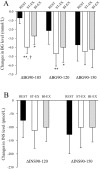Stair ascending-descending exercise accelerates the decrease in postprandial hyperglycemia more efficiently than bicycle exercise
- PMID: 29071088
- PMCID: PMC5640078
- DOI: 10.1136/bmjdrc-2017-000428
Stair ascending-descending exercise accelerates the decrease in postprandial hyperglycemia more efficiently than bicycle exercise
Abstract
Objective: Stair climbing-descending exercise (ST-EX) is a convenient method to increase exercise intensity. We compared the acute effect of ST-EX on lowering postprandial hyperglycemia with that of constant bicycle exercise (BI-EX) performed at the same heart rate (HR).
Research design and methods: Seven people with type 2 diabetes and seven with impaired glucose tolerance volunteered for this study. The step rate for ST-EX and work rate for BI-EX were individually determined to correspond to high-moderate to low-vigorous intensity (HR ~130 beats per minute). For the ST-EX trial, the subjects performed 16 repetitions of walking down one flight of stairs followed by climbing up to the starting point (~8 min in duration) 90 min after consuming a test meal. For the BI-EX trial, the subjects performed a constant pedaling exercise for the same duration at the same time after the meal.
Results: The reduction in blood glucose (BG) level between 90 and 105 min after a meal was significantly greater for ST-EX (-4.0±0.7mmol/L) than for BI-EX (-2.7±0.9mmol/L). The net reduction in BG between 90 and 105 min was also significantly greater for ST-EX (-3.2±0.7mmol/L) than for BI-EX (-2.0±0.6mmol/L). Serum insulin levels did not differ between the groups. Oxygen consumption for ST-EX was higher than that for BI-EX, but the blood lactate level and respiratory exchange ratio (RER) for ST-EX were lower than those for BI-EX.
Conclusions: Compared with BI-EX performed at the same HR, ST-EX more rapidly decreased postprandial BG level with lower blood lactate and RER responses. A short bout of ST-EX may be clinically useful to acutely ameliorate BG levels after meals.
Keywords: exercise prescription; muscle glucose uptake; oxygen consumption; postprandial blood glucose.
Conflict of interest statement
Competing interests: None declared.
Figures


References
-
- DECODE Study Group, the European Diabetes Epidemiology Group. Glucose tolerance and cardiovascular mortality: comparison of fasting and 2-hour diagnostic criteria. Arch Intern Med 2001;161:397–405. - PubMed
LinkOut - more resources
Full Text Sources
Other Literature Sources
